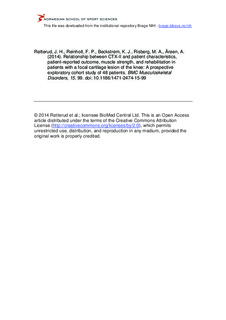| dc.description.abstract | Background: C-telopeptide fragments of type II collagen (CTX-II) are created during articular cartilage breakdown and CTX-II is considered useful as a biomarker of osteoarthritis. The primary objective of the present study was to explore the relationship between urinary CTX-II concentration and patient characteristics, patient-reported outcome, muscle strength, and rehabilitation in patients with isolated focal knee cartilage lesions. Furthermore, the secondary objective was to examine differences in urinary CTX-II concentration between patients with focal cartilage lesions and healthy controls.
Methods: 48 patients (mean age 33.4 years, standard deviation 9.0) with a focal full-thickness (International Cartilage Repair Society grade 3 or 4) cartilage lesion on the medial or lateral femoral condyle were included. After baseline assessments, the patients completed a 3-month rehabilitation program and 44 patients attended the 3 month follow-up. Baseline and follow-up assessments consisted of urinary CTX-II, the Knee Injury and Osteoarthritis Outcome Score (KOOS), and isokinetic quadriceps and hamstring muscle strength measurements. CTX-II was also analysed in urine samples from 6 healthy individuals, serving as normal controls. Correlations were classified as very weak (correlation coefficient [r] < 0.20), weak (r = 0.20 – 0.39), moderate (r = 0.40 – 0.59), strong (r = 0.60 – 0.79), and very strong (r > 0.80).
Results: Except for age and quadriceps strength, no significant correlations were found between CTX-II concentrations and baseline characteristics, KOOS, or muscle strength. Except for age, all correlations were considered as weak or very weak. The patients with a focal cartilage lesion had significantly higher mean CTX-II concentration than the healthy control individuals both at baseline (p = 0.001) and at follow-up (p = 0.001). The mean CTX-II concentration tended to decrease during rehabilitation, but the reduction was not significant (p = 0.076).
Conclusions: The current exploratory study demonstrated that patients with a focal cartilage lesion of the knee had higher concentrations of urinary CTX-II than healthy individuals. In addition, CTX-II concentration tended to decrease during rehabilitation. | nb_NO |
